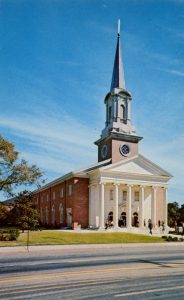Tiffany Stained Glass Windows in Decatur, Chapel on Sycamore
Explore the Tiffany Windows of Sycamore Chapel
By Marissa Howard, Programs and Membership Coordinator
Former Decatur First United Methodist Church, 1899
Architect Gottfried Norrman (1848-1909)
Romanesque Revival is characterized by the thick stone masonry, rounded arches, and simplified windows. Buildings typically feature one or more square unadorned towers. And the Belfry (the area with the bell) would be defined by simple round columns. Buildings would be asymmetrical, have irregular plana, and also be considered picturesque.
This Revival style was modeled on Romanesque architecture popular from 1100-1200, preceding Gothic architecture.
Beginning in the 1860s, America went crazy for the medieval, often blending Romanesque, Gothic, and Tudor styles within one structure. This video details how Collegiate Gothic swept institutes of higher learning, promoting an atmosphere of intelligence, beauty, and antiquity. This church was built in 1899 amid this trend promoting the picturesque and beautiful.
Special features to note:
- Stone Mountain granite walls with walled buttresses
- Squat square tower
- The bell tower features a pyramidal roof and short columns
- Exterior walls are one story with walled buttresses and overhanging eaves

The architect was Gottfried Norrman, who came to Atlanta in 1881 after an extensive architectural education in Germany and his native Sweden He designed opulent commercial, educational, or industrial buildings, generally in the Romanesque Revival and Queen Anne styles. He designed Ivy Hall, the extraordinary Queen Anne Style home on Ponce and Piedmont, owned and renovated by SCAD.
He was an extremely well-known Atlanta architect who helped found the American Institute of Architecture, Atlanta chapter. He unfortunately took his own life, and the story was front page news. There was even a long poem published about him. His tragic death in 1909 came right after he became a partner with Hentz and Neel Reid.
Decatur’s First United Methodist Church is the oldest congregation in Decatur, having organized in 1823. This building was initially named Anderson Memorial in honor of W. D. Anderson, Presiding Elder of the District in 1891-94. The cost of construction was $6,626. The two transepts were added in 1916 to accommodate the growing congregation.
In 1967 a new Wren-Gibbs Style church, designed by Pope H. Fuller was built on East Ponce and North Candler.
The interior features a great deal of warm woodwork, including on the barrel-vaulted ceiling which is highlighted with decorative timber beams. A Tiffany Studio memorial window is located behind the altar.
Louis Tiffany of Tiffany Studios became synonymous with stained glass in the late 19th century in America. A savvy businessman, Tiffany began producing fascinating memorial window catalogs to customize and adorn church walls. Nearly all of the designs were produced by artist Fredrick Wilson. Wealthier patrons could customize a window. DFUMCs memorial window is one such custom piece. Adoration was dedicated to Eliza Ann Pearce, and purchased by her son, John W. Pearce, in 1899.
The Pearce family has a history with this Methodist church. Eliza Ann was originally a Glenn – the sister of the namesake of Glenn Memorial Church at Emory. She married Rev. Gadwell Pearce, one of the reverends at this church until the 1860s. The family home is the ornate Queen Anne style home three doors down Sycamore Drive in Decatur.

This window is characteristic of Tiffany Studios’ well-known Art Nouveau style. Art Nouveau (new art) was the culmination of the wealth, artisans, and national pride that spread across Europe in the late 1800s. Popular from 1890-1914, the art movement blurred the lines between applied art (architecture, furniture, and fashion) and fine art (painting, sculpture). It aimed to reject Academic art as too stuffy and dark, and Historical styles like Beaux art and Neoclassical. The Art Nouveau movement was cut short due to World War I but became the precursor to other modern art movements of the 20th Century. Art Nouveau embraced nature, asymmetry, curves, and long lines, and has a graphic art quality. This is not Claude Monet’s Impressionism or Turner’s Landscape Romanticism.
Art Nouveau often featured symbols, folk imagery, and mythology. Its artists were heavily influenced by the Byzantine Empire and Japanese art.
Art Nouveau did not take off in the States as it did in Europe, but became a link between historical styles and modernity in the 20th century. The ripple effects of Art Nouveau can be seen in the work of architects Louis Sullivan and Frank Lloyd Wright. Tiffany began his artistic career by painting, inspired by his travels across Europe and the Near and Far East. He began experimenting with glass in the late 1870s and built his glass studio in 1893. Tiffany revolutionized glass techniques, patenting his glass as Favrile, after the Old English word fabrile (hand-wrought). We can see many of the revolutionary techniques used in his work Adoration featured in the Chapel on Sycamore.
The window shows incredible detail on the faces—they are soft, with individual strokes of highlighted hair, lips, eyebrows, and unique skin colors. This is not a weeping angel. This is a triumphant, exuberant angel. The center angel, Eliza, is floating above the ground. The face is most likely done in her likeness, which was common practice for custom Tiffany Studio design commissions. Eliza is uplifted toward the heavens, toward receiving angels. Tiffany’s designs were not somber but rather joyous and full of celebration.
These windows made use of complementary, or opposite, colors on the color wheel to provide great contrast of the elements. Look at the use of an orange robe with a blue belt. Other combinations include purple and yellow, blue and yellow, seafoam green and bright orange. This color wheel technique is common in Art Nouveau paintings.
Eliza is the only figure in white and gold blazing into the sky. The background color of the wings connects her to the Byzantine-styled angels surrounding her.
Kudos to Williams Tunesic law firm for their award winning renovation of this important historic structure. You can learn more about The Chapel on Sycamore here.










